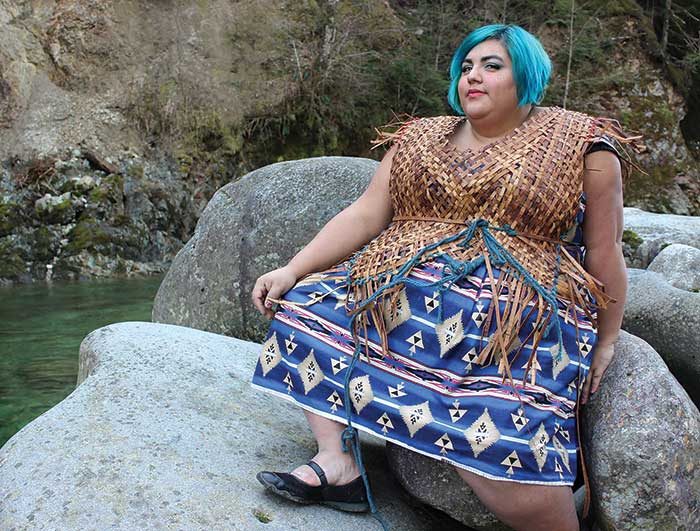Raven John: Transformation & Art
By Tessa Vikander
Raven John’s namesake, the raven, is “a trickster, a teacher, a transformer,” something John relates to as a two-spirit artist and activist.
John – of Coast Salish (Sechelt) and Stó:lō (Chawathil) background — is a recent graduate from Emily Carr University and is currently enrolled in the Northwest Coast Jewellery Arts program at Native Education College (NEC). John was also a participant in this year’s two-spirit themed Queer Arts Festival in Vancouver.
The Sentinel caught up with John at NEC.
Sentinel: Can you tell me about the current work you’re doing with Amanda Strong [of the Indigenous stop-motion animation company Spotted Fawn Productions]?
John: The most recent film that they’re working on is addressing gender fluidity in relation to Indigenous spirituality and story which is really important to me because transformation is a very big part of Coast Salish Indigeneity, a lot of the cultures rely very heavily on transformation, you’re gifted or cursed through transformation in many different ways and places are given their namesake because of people who are transformed into mountains, rivers the fish and beasts that we feed from are sometimes derived from people who sacrificed their bodies to be, to give the people access to those animals.
(For the film) I’ve been sculpting the faces of the main characters, both animal spiritual and human, and working with them on some of the design aspects of those characters. I’ll be working with them on some of their set decorating as well.
Sentinel: You mention the importance of stories in Coast Salish culture. Are there any particular stories that you relate to in terms of your own gender fluidity?
John: Quite obviously, raven is very strong with me and my family. The raven is a trickster, a teacher, a transformer, and the first story I was told growing up, about the raven, was about how the raven stole the sun and the stars, and in the story raven transforms itself into a pine needle, which drops into the drinking water of the chieftain’s daughter and he then impregnates her and becomes her child, who later, being a spoiled brat, steals the treasures of that chieftain which were the sun, moon and stars.
I remember very specifically when I was around five standing in front of the patio doors, in Chilliwack, in the house I grew up in, and seeing my reflection vaguely through the rain, with my long hair and my childish features I actually turned to my mom and [even though I was born female] I asked her if I was a girl or a boy. “Am I a girl now?” And that was, I guess, because I developed quite quickly, which, I was always very tall, which was very hard to deal with, especially living in a small town, my mother had to *laughs* basically be with me at all times because people would assume that I was older than I was, and being objectified at such a young age was very difficult. But before I started developing through my sexual maturity I felt most at home dressing androgynously. Which obviously as I progressed through puberty became very difficult to pass, and that’s something that I struggle with now because I feel that my gender and sexual identity are heavily related to my spiritual ties to the stories of raven and raven as a transformer.
Sentinel: Do you remember what your mom said to you when you asked her that question?
John: She said that I was obviously a girl.
Sentinel: How did that resonate with you?
John: It didn’t affect me too much as a kid, except that I was a bit frustrated that I would ever have to choose, that I had one way, supposedly one way to live. and I feel like I should be able to express myself as he, she or they, but given my body type it’s very difficult to do that, well to pass in a way that I would be satisfied.
Sentinel: You now identify as two-spirit. Can you explain what that means to you?
John: For me it means having a gender and sexual orientation in relation to my spirituality as an Indigenous person, someone from Coast Salish and Stó:lō territories.
Sentinel: Going forward what are your plans?
John: For the rest of my life I’m hoping to be making art, just continuing to make art, and I plan on taking up spaces that future generations can see themselves in and themselves beyond. When I was a teenager or a youth, going to Emily Carr, I didn’t think that that was possibility, and I sometimes mourn for myself that I did not think highly enough of myself that I could go to this university, and get my degree from it. And a lot of that has to do with the legal and institutionalized and social racism that I encountered growing up. But seeing the cleverness and humour and talent in the youths from my communities in Hope and in Mission and Chilliwack I know that how far they can go and that they can go much farther than me in their careers if they had the support, they had the opportunity and it’s been my goal to take up space in the public eye to show indigenous youth that they can do what I’m doing, and that they can do much more.
This interview has been shortened and edited. Some parts of this interview also appeared in a piece for Megaphone Magazine.




